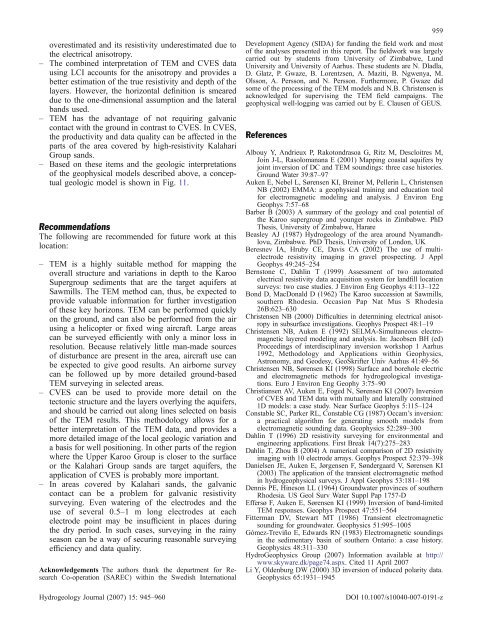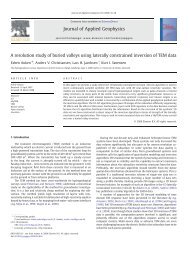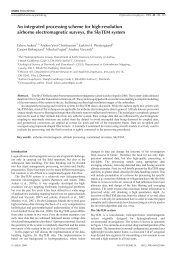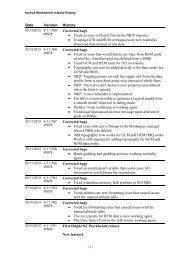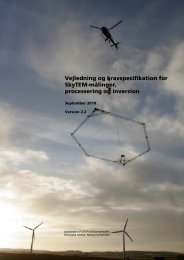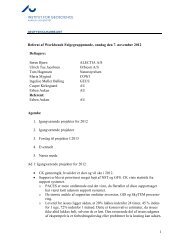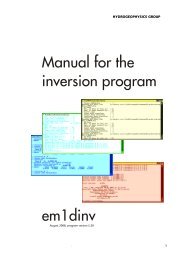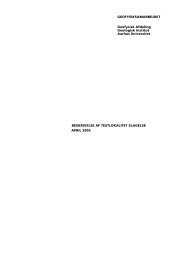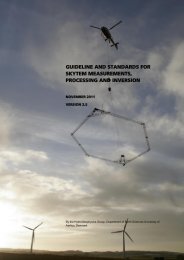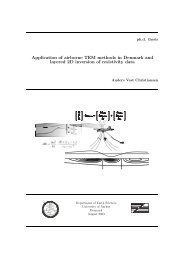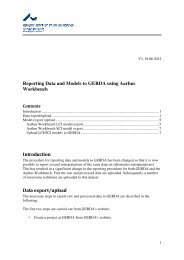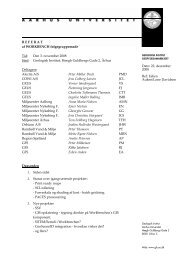Geophysical and hydrogeologic investigation of groundwater in the ...
Geophysical and hydrogeologic investigation of groundwater in the ...
Geophysical and hydrogeologic investigation of groundwater in the ...
- No tags were found...
Create successful ePaper yourself
Turn your PDF publications into a flip-book with our unique Google optimized e-Paper software.
overestimated <strong>and</strong> its resistivity underestimated due to<strong>the</strong> electrical anisotropy.– The comb<strong>in</strong>ed <strong>in</strong>terpretation <strong>of</strong> TEM <strong>and</strong> CVES dataus<strong>in</strong>g LCI accounts for <strong>the</strong> anisotropy <strong>and</strong> provides abetter estimation <strong>of</strong> <strong>the</strong> true resistivity <strong>and</strong> depth <strong>of</strong> <strong>the</strong>layers. However, <strong>the</strong> horizontal def<strong>in</strong>ition is smeareddue to <strong>the</strong> one-dimensional assumption <strong>and</strong> <strong>the</strong> lateralb<strong>and</strong>s used.– TEM has <strong>the</strong> advantage <strong>of</strong> not requir<strong>in</strong>g galvaniccontact with <strong>the</strong> ground <strong>in</strong> contrast to CVES. In CVES,<strong>the</strong> productivity <strong>and</strong> data quality can be affected <strong>in</strong> <strong>the</strong>parts <strong>of</strong> <strong>the</strong> area covered by high-resistivity KalahariGroup s<strong>and</strong>s.– Based on <strong>the</strong>se items <strong>and</strong> <strong>the</strong> geologic <strong>in</strong>terpretations<strong>of</strong> <strong>the</strong> geophysical models described above, a conceptualgeologic model is shown <strong>in</strong> Fig. 11.RecommendationsThe follow<strong>in</strong>g are recommended for future work at thislocation:– TEM is a highly suitable method for mapp<strong>in</strong>g <strong>the</strong>overall structure <strong>and</strong> variations <strong>in</strong> depth to <strong>the</strong> KarooSupergroup sediments that are <strong>the</strong> target aquifers atSawmills. The TEM method can, thus, be expected toprovide valuable <strong>in</strong>formation for fur<strong>the</strong>r <strong><strong>in</strong>vestigation</strong><strong>of</strong> <strong>the</strong>se key horizons. TEM can be performed quicklyon <strong>the</strong> ground, <strong>and</strong> can also be performed from <strong>the</strong> airus<strong>in</strong>g a helicopter or fixed w<strong>in</strong>g aircraft. Large areascan be surveyed efficiently with only a m<strong>in</strong>or loss <strong>in</strong>resolution. Because relatively little man-made sources<strong>of</strong> disturbance are present <strong>in</strong> <strong>the</strong> area, aircraft use canbe expected to give good results. An airborne surveycan be followed up by more detailed ground-basedTEM survey<strong>in</strong>g <strong>in</strong> selected areas.– CVES can be used to provide more detail on <strong>the</strong>tectonic structure <strong>and</strong> <strong>the</strong> layers overly<strong>in</strong>g <strong>the</strong> aquifers,<strong>and</strong> should be carried out along l<strong>in</strong>es selected on basis<strong>of</strong> <strong>the</strong> TEM results. This methodology allows for abetter <strong>in</strong>terpretation <strong>of</strong> <strong>the</strong> TEM data, <strong>and</strong> provides amore detailed image <strong>of</strong> <strong>the</strong> local geologic variation <strong>and</strong>a basis for well position<strong>in</strong>g. In o<strong>the</strong>r parts <strong>of</strong> <strong>the</strong> regionwhere <strong>the</strong> Upper Karoo Group is closer to <strong>the</strong> surfaceor <strong>the</strong> Kalahari Group s<strong>and</strong>s are target aquifers, <strong>the</strong>application <strong>of</strong> CVES is probably more important.– In areas covered by Kalahari s<strong>and</strong>s, <strong>the</strong> galvaniccontact can be a problem for galvanic resistivitysurvey<strong>in</strong>g. Even water<strong>in</strong>g <strong>of</strong> <strong>the</strong> electrodes <strong>and</strong> <strong>the</strong>use <strong>of</strong> several 0.5–1 m long electrodes at eachelectrode po<strong>in</strong>t may be <strong>in</strong>sufficient <strong>in</strong> places dur<strong>in</strong>g<strong>the</strong> dry period. In such cases, survey<strong>in</strong>g <strong>in</strong> <strong>the</strong> ra<strong>in</strong>yseason can be a way <strong>of</strong> secur<strong>in</strong>g reasonable survey<strong>in</strong>gefficiency <strong>and</strong> data quality.Acknowledgements The authors thank <strong>the</strong> department for ResearchCo-operation (SAREC) with<strong>in</strong> <strong>the</strong> Swedish InternationalHydrogeology Journal (2007) 15: 945–960Development Agency (SIDA) for fund<strong>in</strong>g <strong>the</strong> field work <strong>and</strong> most<strong>of</strong> <strong>the</strong> analyses presented <strong>in</strong> this report. The fieldwork was largelycarried out by students from University <strong>of</strong> Zimbabwe, LundUniversity <strong>and</strong> University <strong>of</strong> Aarhus. These students are N. Dladla,D. Glatz, P. Gwaze, B. Lorentzsen, A. Maziti, B. Ngwenya, M.Olsson, A. Persson, <strong>and</strong> N. Persson. Fur<strong>the</strong>rmore, P. Gwaze didsome <strong>of</strong> <strong>the</strong> process<strong>in</strong>g <strong>of</strong> <strong>the</strong> TEM models <strong>and</strong> N.B. Christensen isacknowledged for supervis<strong>in</strong>g <strong>the</strong> TEM field campaigns. Thegeophysical well-logg<strong>in</strong>g was carried out by E. Clausen <strong>of</strong> GEUS.References959Albouy Y, Andrieux P, Rakotondrasoa G, Ritz M, Descloitres M,Jo<strong>in</strong> J-L, Rasolomanana E (2001) Mapp<strong>in</strong>g coastal aquifers byjo<strong>in</strong>t <strong>in</strong>version <strong>of</strong> DC <strong>and</strong> TEM sound<strong>in</strong>gs: three case histories.Ground Water 39:87–97Auken E, Nebel L, Sørensen KI, Bre<strong>in</strong>er M, Peller<strong>in</strong> L, ChristensenNB (2002) EMMA: a geophysical tra<strong>in</strong><strong>in</strong>g <strong>and</strong> education toolfor electromagnetic model<strong>in</strong>g <strong>and</strong> analysis. J Environ EngGeophys 7:57–68Barber B (2003) A summary <strong>of</strong> <strong>the</strong> geology <strong>and</strong> coal potential <strong>of</strong><strong>the</strong> Karoo supergroup <strong>and</strong> younger rocks <strong>in</strong> Zimbabwe. PhDThesis, University <strong>of</strong> Zimbabwe, HarareBeasley AJ (1987) Hydrogeology <strong>of</strong> <strong>the</strong> area around Nyam<strong>and</strong>hlovu,Zimbabwe. PhD Thesis, University <strong>of</strong> London, UKBeresnev IA, Hruby CE, Davis CA (2002) The use <strong>of</strong> multielectroderesistivity imag<strong>in</strong>g <strong>in</strong> gravel prospect<strong>in</strong>g. J ApplGeophys 49:245–254Bernstone C, Dahl<strong>in</strong> T (1999) Assessment <strong>of</strong> two automatedelectrical resistivity data acquisition system for l<strong>and</strong>fill locationsurveys: two case studies. J Environ Eng Geophys 4:113–122Bond D, MacDonald D (1962) The Karoo succession at Sawmills,sou<strong>the</strong>rn Rhodesia. Occasion Pap Nat Mus S Rhodesia26B:623–630Christensen NB (2000) Difficulties <strong>in</strong> determ<strong>in</strong><strong>in</strong>g electrical anisotropy<strong>in</strong> subsurface <strong><strong>in</strong>vestigation</strong>s. Geophys Prospect 48:1–19Christensen NB, Auken E (1992) SELMA-Simultaneous electromagneticlayered model<strong>in</strong>g <strong>and</strong> analysis. In: Jacobsen BH (ed)Proceed<strong>in</strong>gs <strong>of</strong> <strong>in</strong>terdiscipl<strong>in</strong>ary <strong>in</strong>version workshop 1 Aarhus1992, Methodology <strong>and</strong> Applications with<strong>in</strong> Geophysics,Astronomy, <strong>and</strong> Geodesy, GeoSkrifter Univ Aarhus 41:49–56Christensen NB, Sørensen KI (1998) Surface <strong>and</strong> borehole electric<strong>and</strong> electromagnetic methods for <strong>hydrogeologic</strong>al <strong><strong>in</strong>vestigation</strong>s.Euro J Environ Eng Geophy 3:75–90Christiansen AV, Auken E, Foged N, Sørensen KI (2007) Inversion<strong>of</strong> CVES <strong>and</strong> TEM data with mutually <strong>and</strong> laterally constra<strong>in</strong>ed1D models: a case study. Near Surface Geophys 5:115–124Constable SC, Parker RL, Constable CG (1987) Occam’s <strong>in</strong>version:a practical algorithm for generat<strong>in</strong>g smooth models fromelectromagnetic sound<strong>in</strong>g data. Geophysics 52:289–300Dahl<strong>in</strong> T (1996) 2D resistivity survey<strong>in</strong>g for environmental <strong>and</strong>eng<strong>in</strong>eer<strong>in</strong>g applications. First Break 14(7):275–283Dahl<strong>in</strong> T, Zhou B (2004) A numerical comparison <strong>of</strong> 2D resistivityimag<strong>in</strong>g with 10 electrode arrays. Geophys Prospect 52:379–398Danielsen JE, Auken E, Jørgensen F, Søndergaard V, Sørensen KI(2003) The application <strong>of</strong> <strong>the</strong> transient electromagnetic method<strong>in</strong> hydrogeophysical surveys. J Appl Geophys 53:181–198Dennis PE, H<strong>in</strong>eson LL (1964) Groundwater prov<strong>in</strong>ces <strong>of</strong> sou<strong>the</strong>rnRhodesia. US Geol Surv Water Suppl Pap 1757-DEffersø F, Auken E, Sørensen KI (1999) Inversion <strong>of</strong> b<strong>and</strong>-limitedTEM responses. Geophys Prospect 47:551–564Fitterman DV, Stewart MT (1986) Transient electromagneticsound<strong>in</strong>g for <strong>groundwater</strong>. Geophysics 51:995–1005Gómez-Treviño E, Edwards RN (1983) Electromagnetic sound<strong>in</strong>gs<strong>in</strong> <strong>the</strong> sedimentary bas<strong>in</strong> <strong>of</strong> sou<strong>the</strong>rn Ontario: a case history.Geophysics 48:311–330HydroGeophysics Group (2007) Information available at http://www.skyware.dk/page74.aspx. Cited 11 April 2007Li Y, Oldenburg DW (2000) 3D <strong>in</strong>version <strong>of</strong> <strong>in</strong>duced polarity data.Geophysics 65:1931–1945DOI 10.1007/s10040-007-0191-z


